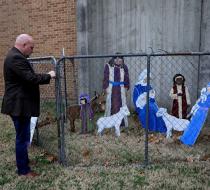Fenced-In Nativity Scene Favorite
The nativity scene at Fellowship Congregational Church in Tulsa, Okla., looks a little different this year: There is a chain-link fence surrounding Mary, Joseph and the baby Jesus.
The display has been up since the beginning of December, but it drew news coverage this week after the church changed the message on its marquee to read, “The holy family was a migrant family,” and posted photos of the nativity on Facebook.
The scene is both an acknowledgment that the Christmas story is a migration story, and also a response to the Trump administration’s efforts to discourage people from seeking refuge in the United States, the Rev. Chris Moore, the church’s lead pastor, said in an interview on Thursday.
Various religious texts, including the Gospel of St. Matthew, describe how the holy family sought asylum in Egypt after Jesus was born.
“An angel of the Lord appeared to Joseph in a dream, saying, ‘Arise, take the young child and his mother, flee to Egypt, and stay there until I bring you word; for Herod will seek the young child to destroy him,’” the New King James Version of Matthew 2:13-14 says. “When he arose, he took the young child and His mother by night and departed for Egypt.”
There are migrants today who are “fleeing the same kinds of oppression and threats to their safety that the holy family was fleeing,” Mr. Moore said.
The nativity fence — like similar displays this year at other places of worship — alludes in part to the practice of separating migrant children from their parents, which led to about 3,000 family separations at the United States’ southern border. In June, Mr. Trump signed an order rescinding the practice.
But, Mr. Moore added, Mr. Trump’s administration was not the first to crack down on migrants.
“It’s a place of shame or regret to me that this is the first year I’ve put this up because I was silent during the last administration on this issue,” he said.
About 15,000 migrant children are currently housed in more than 100 shelters in the United States; some are adolescents who crossed the border alone, and others were separated from their parents.
The Obama administration and earlier administrations also detained immigrant families and children, but did not have a policy to separate children from their families as a means of deterring other migrants from crossing the border.
Fellowship Congregational Church has not been alone in protesting immigration policy under the Trump administration. Progressive churches elsewhere in the country have used their nativity scenes to make similar political statements this year.
At St. Susanna Parish in Dedham, Mass., a statue of the baby Jesus was placed in a cage and displayed this month. The three wise men could be seen gazing at him, separated by a tall barrier.
In that display, Jesus represented the children being separated from their parents at the border, the parish’s pastor, Father Stephen Josoma, told CBS News, and the wise men represented migrants stuck behind a border wall.
“Jesus was about taking care of one another,” he said. “This is not the way to take care of one another.”
Pat Ferrone, a member of the committee at St. Susanna’s that conceived of the idea, told the CBS station that they did not aim to “scandalize anyone.”
“We’re trying to reflect back a reality that has to be looked at,” she said. Last year, the church’s nativity scene sought to highlight America’s deadliest shootings.
Christ Church Cathedral in Indianapolis displayed its nativity scene months earlier, in July, installing barbed wire above the fence that surrounded the holy family in protest of President Trump’s zero tolerance immigration policy.
“I know what the Bible said,” the Rev. Stephen Carlsen, dean and rector of Christ Church Cathedral, told USA Today at the time. “We’re supposed to love our neighbors as ourselves.”
In November, Mr. Moore, of Fellowship Congregational Church, traveled from Tulsa to Texas, where he and other religious leaders stood near the main gate of a detention camp for migrant children in Tornillo, about 35 miles southeast of El Paso on the Mexico border.
They sang and prayed. And when buses drove by, they became silent. Mr. Moore later recounted during a sermon to his congregation that they believed that the buses held immigrants who had sought refuge and instead found “a kind of prison.”
“I do think the church has a very important role to play in the political life,” he said on Thursday. “It’s the partisanship that I don’t want to be involved in.”
By Christina Caron
New York Times
December 21, 2018







